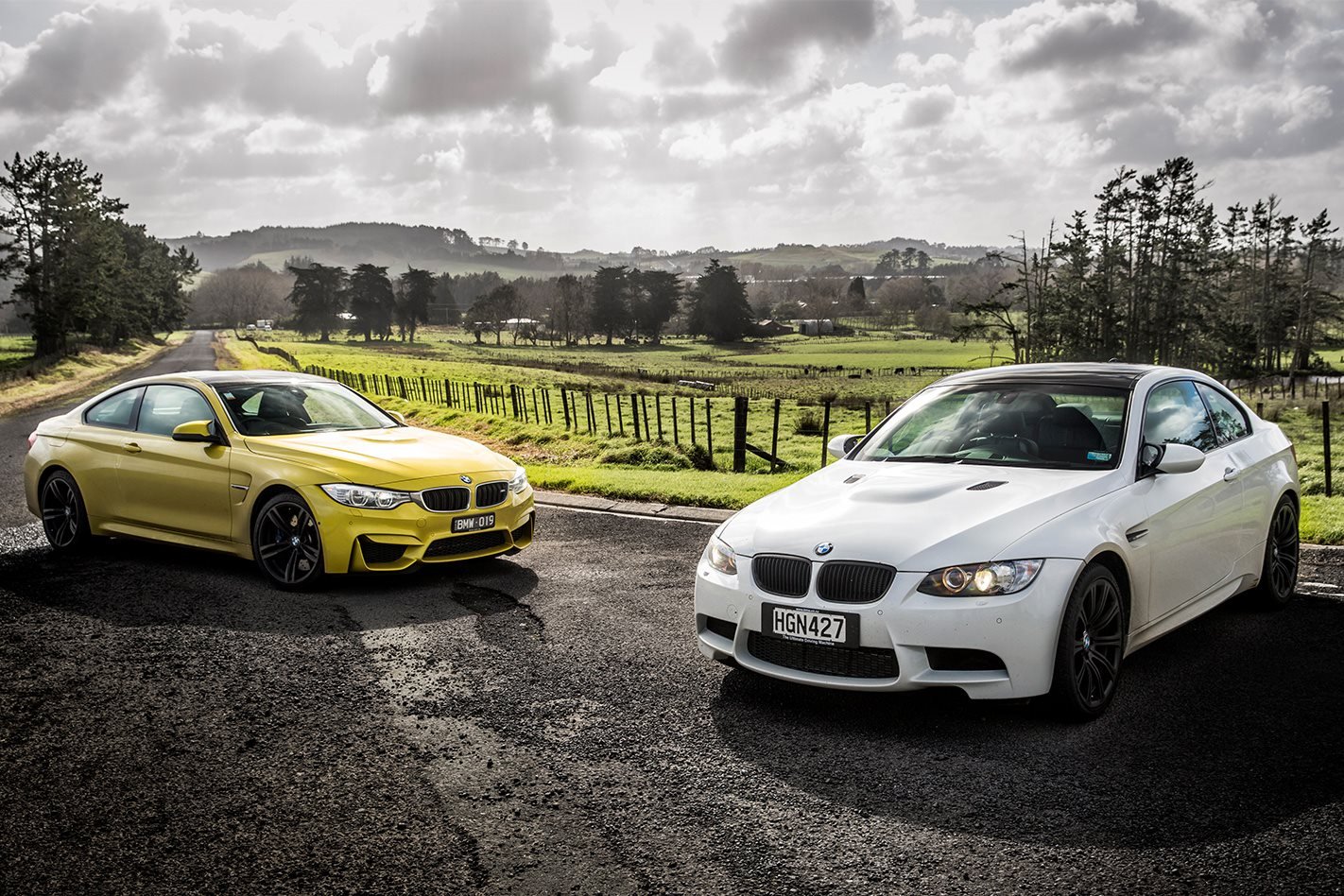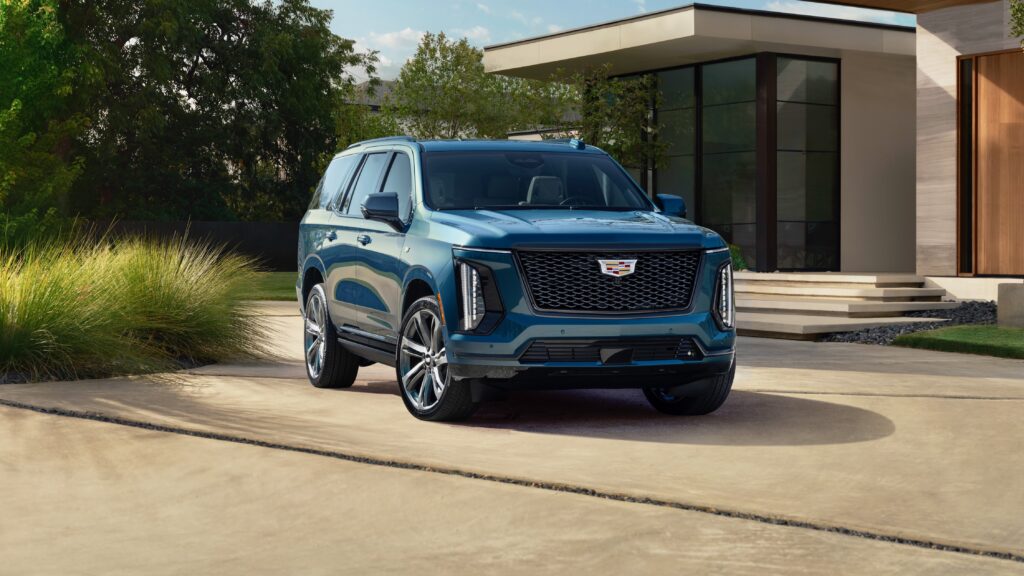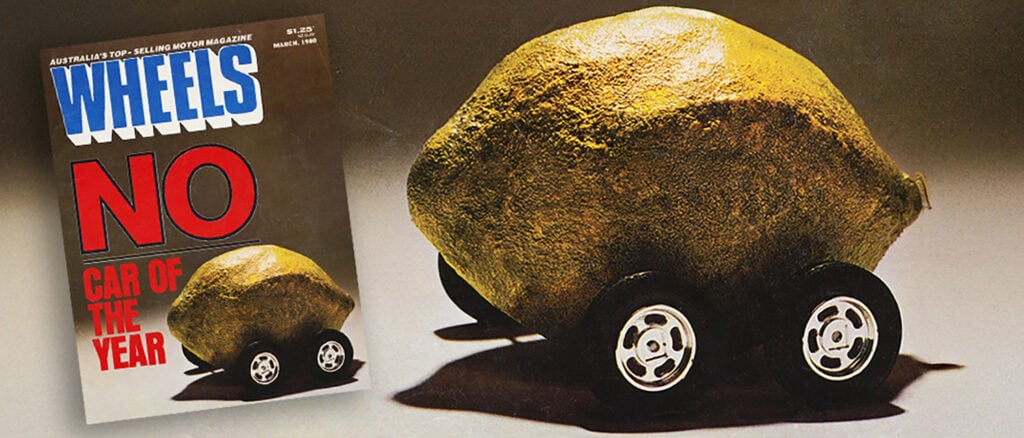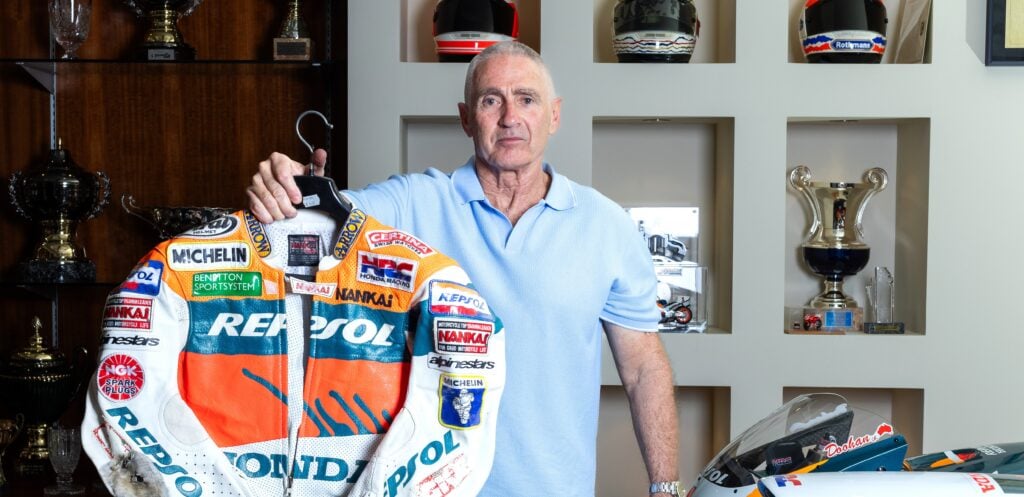The first hurdle any new product must clear, be it a television, a toaster or a toothbrush, is to improve on its predecessor.
Cars, of course, are no different, but what if you’re trying to improve on perfection? The BMW M3 is a MOTOR hero, pretty much always has been.
Both E36 and E46 iterations won Performance Car of the Year – the latter almost did it twice – and while the E90-series didn’t quite achieve those dizzying heights, the way it comes alive when being hammered – that incredible atmo V8 singing at 8000rpm – makes it one of our favourite driving tools to this day.
So you could forgive the engineers responsible for the new F80/F82 (sedan/coupe) for tossing and turning in their beds at night, waking in a fitful sweat muttering “improve the M3? Did anyone ask Da Vinci to improve the Mona Lisa?”
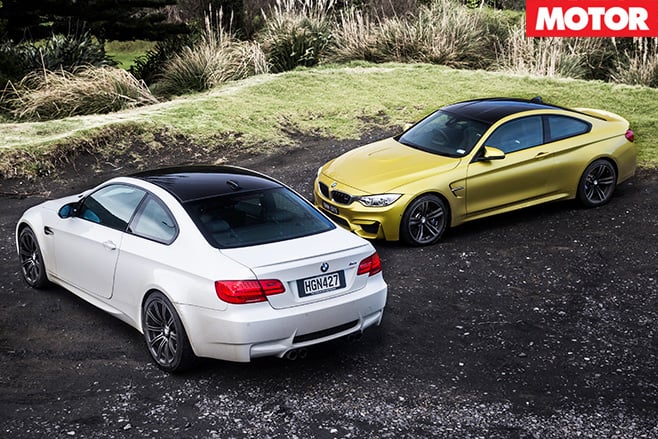
To judge if the talented folk at M Division have successfully married these two contradictory goals, we have the serpentine roads of New Zealand’s North Island and arguably the new car’s toughest competitor.
A comparison test with its closest rivals awaits BMW’s new hi-po hero later in the year, but for now its greatest foe is the enemy within, its predecessor, the E92 M3. Credit to BMW for allowing this test to happen – not every company would.
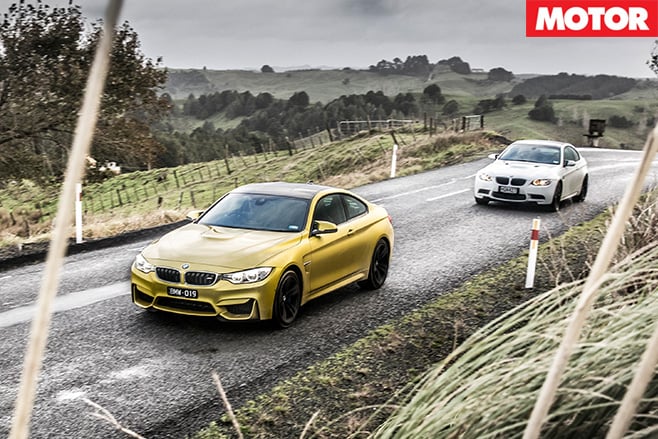
The idea is that the new name allows for greater styling differentiation between sporty coupe and sensible sedan, and the designers have seized the opportunity with both hands, the M4 exuding testosterone from every sharply-defined crease and gaping vent.
In comparison, the skinnier, more upright E92 Coupe looks weedy and undernourished, Bruce Banner to the M4’s Hulk. The carbon roof is a dead giveaway to those in the know, but parked next to its steroidal successor, the M3 is subtle almost to the point of anonymity.
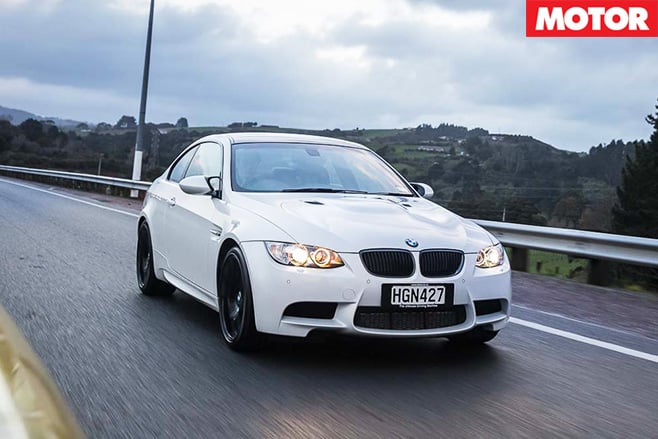
There’s also nowhere to put anything – drinks, wallets, keys, etc – but one press of the starter button fires the 3999cc V8 into life and suddenly a lack of space ceases to matter.
It’s a sensational engine, its motorsport breeding obvious in its razor-sharp throttle response (once the ‘Sport’ button has been pushed) and the ease with which it revs to its 8400rpm cutout. Hearing an E92 M3 charge towards you in a wail of induction noise is one of motoring’s great experiences.
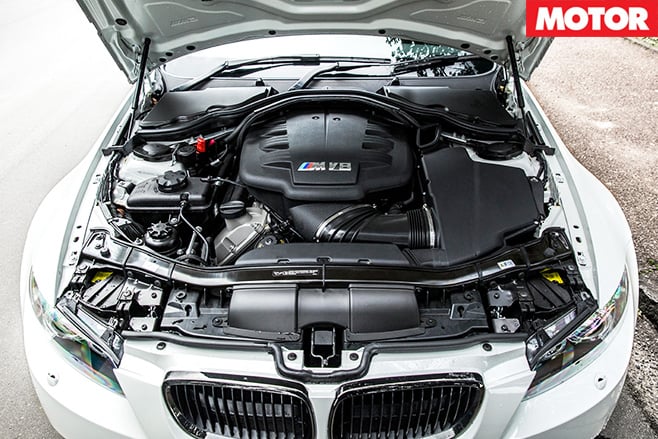
Sitting on 100km/h in seventh equates to 2500rpm, which is great for response but rather catastrophic for fuel consumption.
While still reasonably slick, the DCT feels a bit off the pace compared to the latest-gen dual-clutch ’boxes, so we’d stick (pardon the pun) with the six-speed manual. That way you can forget about which of the 11 gearbox settings you need, set everything else (engine, steering, dampers, DSC) to Sport and just remember to press the ‘M’ button on the steering wheel every time you take off.
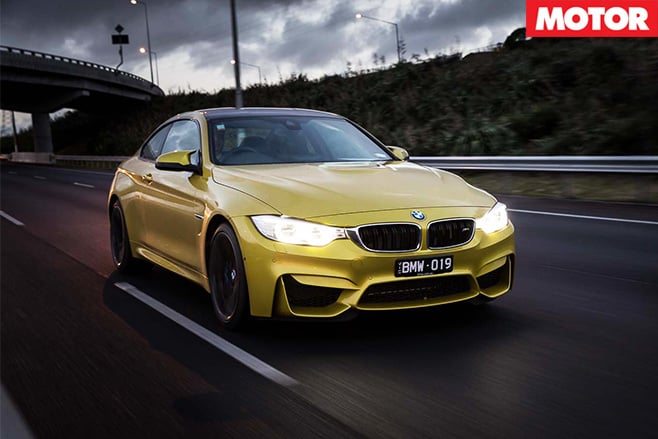
For me it’s everything In Comfort for M1 (cruise mode) and throttle in Sport Plus, suspension in Sport and steering in Comfort for M2 (attack mode). Choosing a gearbox, though, has been made considerably more difficult.
The six-speed manual is now optional at no cost and has been significantly revised, losing 12kg and now automatically blipping the throttle on downshifts, but we’re yet to try it as our test car is fitted with the standard seven-speed DCT.
Though it adds 40kg, the self-shifter drops the claimed 0-100km/h time from 4.3 to 4.1sec and cuts claimed consumption and emissions from 8.8L/100km and 204g/km to 8.3L/100km and 194g/km respectively.
More importantly, it’s near-flawless in operation; taking off smoothly requires patience as there’s no ‘creep’ engineered into the system but once under way it shifts with the speed and precision of a Kobe Bryant jump shot.
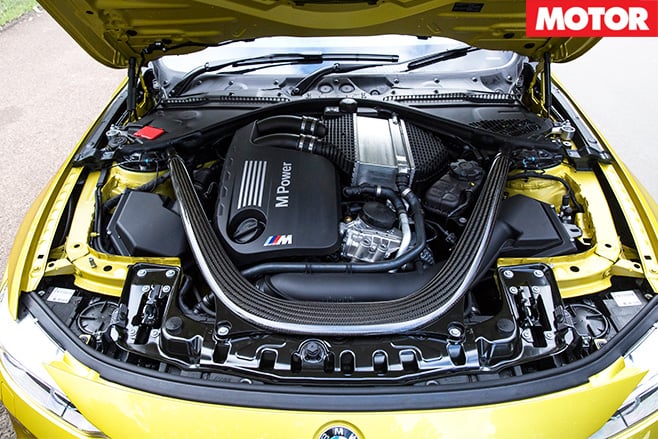
The initial power delivery is just as linear as the old V8, only massively more potent. By 1400rpm it’s surpassed the V8’s peak torque figure of 400Nm; at 1850rpm it generates peak twist of 550Nm, a figure it sustains until 5500rpm, at which point 317kW takes over until 7300rpm.
Is it as exciting as the old V8? Not quite. It lacks that incredible crescendo, the impression of never-ending rpm. Power continues to the 7600rpm cut-out, but it’s more effective to shift between 6000-6500rpm and mine the rich torque seam.
As a result, getting the best out of the M4 demands a new approach. Whereas in the E92 you’re constantly changing gear to stay in the magic 5000rpm-plus zone, third gear is often all that’s required in the F82.
With the engine set to Sport Plus, response is brilliant and turbo lag non-existent thanks to the ECU feeding fuel into the engine to keep the turbos spinning even when off-throttle.
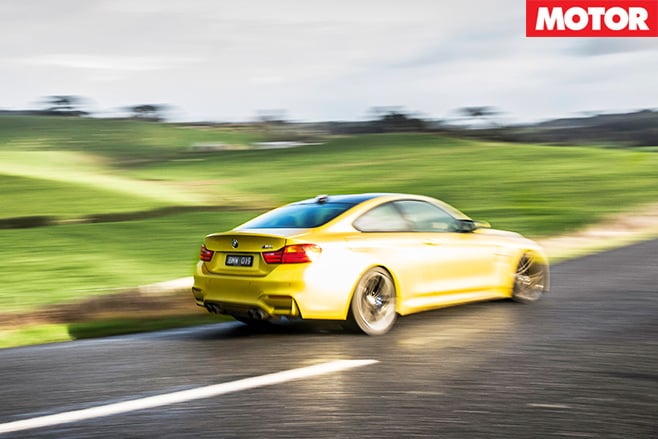
It’s incredibly stable yet any losses in grip are easily corrected when its limits are broached. Despite the switch to electro-mechanical power steering, there’s plenty of feel from the front end and the electronically-controlled locking diff makes heroic oversteer a breeze.
On a damp back-road, though, the game changes somewhat. The level of front grip is such that understeer is non-existent, but on a slippery surface the M4 will easily spin its rear wheels all the way into fourth gear.
We’ll reserve final judgement until we try the car on local roads in dry conditions, but the increase in grip does make the car’s limits harder to access on public roads and its responses snappier once you do find them.
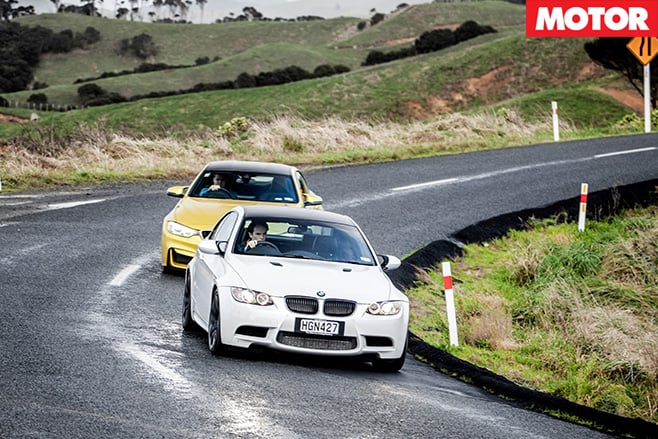
Back on the motorway, both cars prove equally impressive as grand tourers. Neither is particularly refined when it comes to tyre noise, at least not on NZ’s exceptionally coarse roads, but both ride beautifully in either ‘Comfort’ or ‘Sport’.
Drive the E92 M3 and F82 M4 back-to-back and you discover that, like many siblings, while they share DNA, they’re very different in personality. Both I and MOTOR contributor Adam Davis agree we enjoy driving the E92 more, though there is undoubtedly a degree of subconscious sentimentality in that conclusion.
Perhaps the most telling difference is that after almost 400km of varied driving, the older car is on fumes whereas the F82 is still a quarter-full, despite a smaller tank. The M4 is not only much faster than its predecessor, it uses far less fuel in the process.
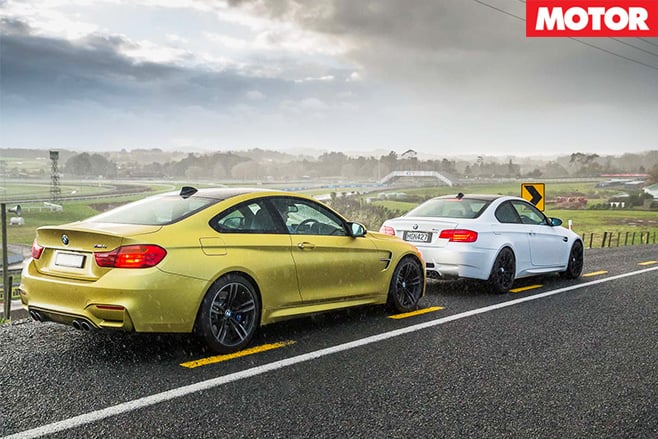
Though the E90/E92 twins still tug at the heart strings, the F80 and F82 are faster, more frugal, better equipped, more practical, but, most importantly, still scintillating to drive. We’ll learn more on our local roads, but for the moment, the first hurdle has been cleared.
| u00a0 | u00a0 | BMW E92 M3 | u00a0 | BMW F82 M4 |
| Body | u00a0 | 2-door, 4-seat coupe | u00a0 | 2-door, 4-seat coupe |
| Drive | u00a0 | rear-wheel | u00a0 | rear-wheel |
| Engine | u00a0 | 3999cc V8, DOHC, 32v | u00a0 | 2979cc inline-6, DOHC, 24v, twin-turbo |
| Bore/stroke | u00a0 | 92.0 x 75.2mm | u00a0 | 89.6 x 84.0mm |
| Compression | u00a0 | 12.0:1 | u00a0 | 10.2:1 |
| Power | u00a0 | 309kW @ 8300rpmu00a0 | u00a0 | 317kW @ 5500-7300rpm |
| Torque | u00a0 | 400Nm @ 3900rpm | u00a0 | 550Nm @ 1850-5500rpm |
| Power/weight | u00a0 | 193kW/tonne | u00a0 | 206kW/tonne |
| Consumption | u00a0 | 11.9L/100km (claimed) | u00a0 | 8.3L/100km (claimed) |
| CO2 Emissions | u00a0 | 283g/km (claimed) | u00a0 | 194g/km (claimed) |
| 0-100km/h | u00a0 | 4.8sec (claimed) | u00a0 | 4.1sec (claimed) |
| Top speed | u00a0 | 250km/h (limited) | u00a0 | 250km/h (limited) |
| Transmission | u00a0 | 7-speed dual-clutch | u00a0 | 7-speed dual-clutch |
| Weight | u00a0 | 1600kg | u00a0 | 1537kg |
| Suspension | u00a0 | struts, A-arms, adaptive dampers, anti-roll bar (f); multi-links, coil springs, adaptive dampers, anti-roll bar (r)u00a0 | u00a0 | struts, A-arms, adaptive dampers, anti-roll bar (f); multi-links, coil springs, adaptive dampers, anti-roll bar (r) |
| L/W/H | u00a0 | 4615/1804/1418mm | u00a0 | 4671/1870/1383mm |
| Wheelbase | u00a0 | 2761mm | u00a0 | 2812mm |
| Tracks | u00a0 | 1538/1539mm (f/r) | u00a0 | 1579/1603mm (f/r) |
| Steering | u00a0 | hydraulically-assisted rack-and-pinion | u00a0 | electrically-assisted rack-and-pinion |
| Brakes | u00a0 | 360mm ventilated/drilled discs, 4-piston calipers (f); 350mm ventilated/drilled discs, 2-piston calipers (r)u00a0 | u00a0 | 380mm ventilated/drilled discs, 4-piston calipers (f); 370mm ventilated/drilled discs, 2-piston calipers (r) |
| Wheels | u00a0 | 19 x 8.5-inch (f); 19 x 9.5-inch (r) | u00a0 | 19 x 9.0-inch (f); 19 x 10.0-inch (r) |
| Tyres | u00a0 | 245/35 ZR19 93Y (f); 265/35 ZR19 100Y (r) Pirelli P Zero | u00a0 | 255/35 ZR19 92Y (f); 275/35 ZR19 100Y (r) Michelin Pilot Supersports |
| Price | u00a0 | $162,400 (2013) | u00a0 | $166,900 |
| Positives | u00a0 | Peerless engine; superb chassis; one of the great driving experiences | u00a0 | So much power; brilliant ride and handling; styling; practicality |
| Negatives | u00a0 | Thirst; needs to be thrashed to give its best; snug interior | u00a0 | A handful in the wet; tyre noise; artificial engine note |


